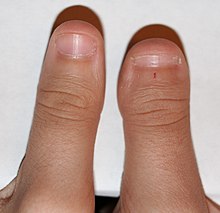In racquet nails (also known as brachyonychia,[1] nail en raquette,[2] and racquet thumb[1]), the nail plate is flattened, the end of the thumb is widened and flattened, and the distal phalanx is abnormally short.[2]: 786 In racquet nails, the width of the nail bed and nail plate is greater than their length.[3]: 657 The condition is painless and asymptomatic.
| Racquet nail | |
|---|---|
 | |
| Brachyonychia in Brachydactyly type D | |
| Specialty | Dermatology |
Racquet nails usually occur on one or both thumbs, but may appear on all fingers and toes. It may be genetic, inherited as an autosomal-dominant trait,[2]: 786 or acquired. Genetic disorders associated with racquet nail include Larsen syndrome, Brooke–Spiegler syndrome, Rubinstein–Taybi syndrome, Hajdu–Cheney syndrome, cartilage–hair hypoplasia, pycnodysostosis, acrodysostosis, and brachydactyly type D.[4]
Acquired racquet nail is associated with acroosteolysis and psoriatic arthropathy.[4] Acquired racquet nail may also be diagnostic of bone resorption in hyperparathyroidism.[5]
Racquet nail often presents with other nail conditions such as onycholysis, koilonychia, pachyonychia, Muehrcke's lines, leuconychia, and half-and-half nails.[5] Cosmetic surgery can be used to improve the appearance of the nails.[4]
See also edit
References edit
- ^ a b Rapini, Ronald P.; Bolognia, Jean L.; Jorizzo, Joseph L. (2007). Dermatology: 2-Volume Set. St. Louis: Mosby. ISBN 978-1-4160-2999-1.
- ^ a b c James, William; Berger, Timothy; Elston, Dirk (2005). Andrews' Diseases of the Skin: Clinical Dermatology. (10th ed.). Saunders. ISBN 0-7216-2921-0.
- ^ Freedberg, et al. (2003). Fitzpatrick's Dermatology in General Medicine. (6th ed.). McGraw-Hill. ISBN 0-07-138076-0.
- ^ a b c Baran, Robert; de Berker, David; Holzberg, Mark; Thomas, Luc (July 23, 2012). Baran and Dawber's Diseases of the Nails and their Management (4th ed.). Wiley-Blackwell. ISBN 978-0470657355. Retrieved 27 June 2014.
- ^ a b Baran, R.; Turkmani, M.G.; Mubki, T. (2014). "Acquired Racquet Nails: a Useful Sign of Hyperparathyroidism". Journal of the European Academy of Dermatology and Venereology. 28 (2): 257–259. doi:10.1111/jdv.12187. PMID 23682576. S2CID 23151745.